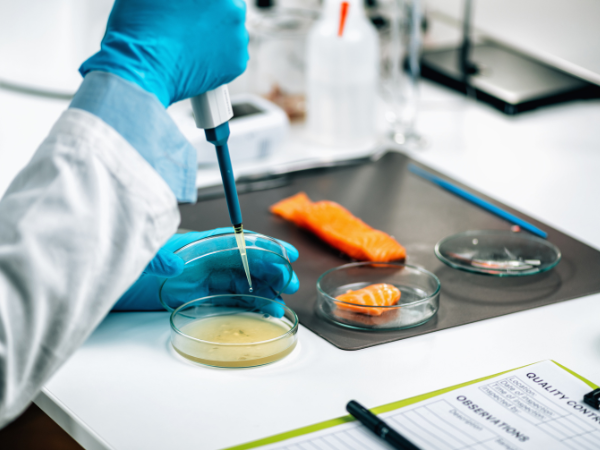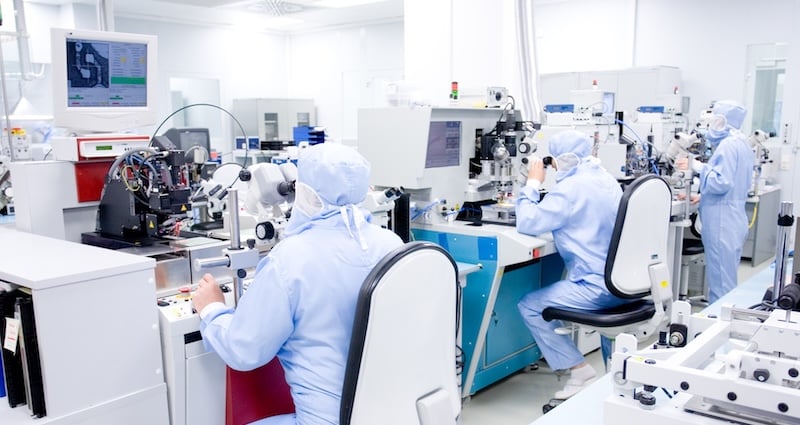
If you’re asking yourself, “what is an ATP test?” and “can it help with environmental monitoring?”, you’ve come to the right place. In some facilities, a visual inspection might be more than enough to determine if your space is clean — but in other spaces, like food production areas or healthcare facilities where bacteria, fungi, and other microscopic contaminants can cause major health problems, you need to be certain of cleanliness.
This is where an ATP swab test can be an invaluable tool.
What is an ATP test?
ATP, or adenosine triphosphate, is an energy molecule present in all living things. Testing for ATP can indicate whether an organism of some type is present or growing on the tested surface, even if no such growth is visible to the naked eye.
The presence of ATP is determined through a quick and simple test. A swab is used to collect a sample from the surface in question. Next, the swab is analyzed using an ATP luminometer. The luminometer creates a reaction with the ATP that generates a bioluminescent reaction. The amount of light produced indicates the amount of ATP present in the collected sample. Results are generally expressed numerically as a relative light unit (RLU), with a high RLU reading indicating that additional cleaning is needed.
It is important to note that ATP testing does not indicate exactly what types of organisms are present. In addition, ATP tests cannot be used to identify the presence of viruses.
All about ATP surface testing
In the pursuit of maintaining the highest standards of cleanliness, especially within environments demanding rigorous hygiene such as healthcare and food preparation areas, ATP surface testing can serve as a pivotal tool. The CDC highlights the utility of ATP Bioluminescence in evaluating the cleanliness of various surfaces through a process that involves a luciferase assay and a luminometer. This method, rooted in over 30 years of application, primarily in the food industry, offers a rapid and efficient means to assess surface hygiene.
Does anything affect ATP surface testing results?
Environmental variables can influence ATP readings. For instance, surfaces that have been disinfected but not thoroughly cleaned of organic matter may inadvertently trigger ATP alarms, suggesting a failure to meet cleanliness benchmarks. Intriguingly, the presence of high concentrations of bleach might dampen the ATP bioluminescence reaction, potentially skewing the readings. This aspect underscores the necessity for surfaces to be dry post-disinfection, especially when bleach-based solutions are employed, before conducting ATP tests.
The establishment of definitive "threshold values" for cleanliness using ATP testing remains a complex endeavor, akin to the challenges faced by traditional culture methods. It emphasizes the need for contextualizing ATP readings against pre-cleaning contamination levels to accurately evaluate cleaning efficacy.
In light of these considerations, the ATP system has consistently proven invaluable in documenting improvements in daily cleaning routines and providing a quantitative assessment of the cleanliness levels of high-touch surfaces. This methodology not only supports the objective evaluation of cleaning practices but also fosters an environment of accountability and continuous improvement in maintaining hygiene standards.
Why is an ATP test important?
An ATP test has become an integral part of cleanliness across many industries where a sanitary environment is critical for end users’ or occupants’ health and safety.
Examples include:
- Food production: The FDA notes that environmental sampling is an essential part of its inspection process for manufacturing plants, commercial kitchens, and similar regulated facilities. This sampling is used to ensure no harmful bacteria, such as Salmonella spp. or Listeria monocytogenes, is present. ATP testing helps these organizations perform their own testing prior to an FDA inspection, quickly verifying that cleaning practices are sufficient.
- Breweries and wineries: As Craft Brewing Business points out, effective ATP monitoring can help prevent any cross-contamination during brewing, ensure product integrity, and improve beer’s shelf life.
- Healthcare facilities: ATP testing serves as a quick and easy strategy to verify that surfaces are in compliance with cleanliness standards. While ATP testing cannot check for the presence of viruses, it can be helpful in demonstrating that high-touch surfaces are free of bacteria, an indication of other potential contamination.
- Cleanroom applications: Pharmaceutical, electronic, and medical device manufacturing facilities must meet stringent cleanliness requirements, set by standards such as ISO 7. ATP testing can be a useful tool in helping to verify that these standards are met.
What is an ATP test swab?
An ATP test swab is a specialized tool designed for collecting samples from various surfaces to measure the presence of ATP. The choice of swab is determined by the manufacturer of the luminometer, the device used to read and quantify ATP levels. The effectiveness of an ATP test swab hinges on its ability to accurately collect and retain ATP without introducing any contamination that could affect the test results.
The manufacturing environment of ATP swabs is of utmost importance. To ensure the integrity of test results, ATP swabs must be produced under stringent ATP controls. This is to prevent inadvertent contamination of the swabs with ATP, which could lead to false readings and misinterpretation of cleanliness levels. The production process is meticulously designed to be ATP-free, a critical quality assurance measure that maintains the swabs' neutrality and reliability in testing.
ATP swab materials
ATP testing relies heavily on the efficacy of ATP test swabs. With the pivotal role they play in identifying ATP, the choice of material for these swabs is paramount for accuracy and reliability. Luminometer manufacturers, responsible for the devices that read and quantify ATP levels, have the discretion to choose the type of swab used in conjunction with their instruments. Among the options, foam swabs are extensively utilized for their conducive properties in ATP collection. Spun fiber and flock swabs also find their place in this application, offering alternative textures and absorption capabilities suitable for gathering ATP from a variety of surfaces. These swabs come in various lengths, including three- and six-inch options, allowing for flexibility and precision in sampling.
This controlled production environment aims to achieve a consensus level of ATP detection that is acceptable to both luminometer and swab manufacturers. It's a delicate balance between sensitivity and specificity, ensuring that the swabs can accurately collect and retain the ATP for analysis without contributing to the ATP load themselves.
The materials used in ATP swabs, and the conditions under which they are produced, are integral to the success of ATP testing. Foam, spun fiber, and flock materials provide the necessary properties for effective sample collection, while ATP-free manufacturing ensures the swabs do not compromise the test results. Together, these factors ensure that ATP testing remains a reliable method for assessing surface cleanliness, aiding industries in maintaining high hygiene standards.
ATP test procedure
When it comes to the ATP test procedure, luminometer manufacturers will provide specific guidelines for recommended ATP sample collection techniques. Utilizing a specialized swab, a standardized area is sampled and subsequently analyzed with a portable handheld luminometer. The process quantifies the total ATP present – encompassing both microbial and non-microbial origins – expressing the results in relative light units.
It's important to note that the sensitivity and readout scales can significantly vary across different commercially available systems. Typically, lower readings correlate with reduced aerobic colony counts, suggesting a cleaner surface. Conversely, elevated readings may indicate a substantial bioburden or the presence of organic debris, including remnants of dead bacteria.
ATP test standards
ATP testing standards have become a cornerstone in evaluating the cleanliness of various facilities, transcending beyond the realms of industries where hygiene is traditionally deemed critical, such as the food sector. This shift towards broader adoption underscores the importance of having empirical evidence to affirm the cleanliness of an environment.
When conducting an ATP test, the test results are presented in Relative Light Units (RLU), with the 3M Clean Trace NG luminometer being a common instrument for this analysis. A higher RLU reading signals a greater presence of ATP and, by extension, a higher likelihood of microbial activity, necessitating further cleaning efforts to mitigate potential health risks. Setting specific RLU thresholds for pass, caution, and fail categories can significantly enhance the effectiveness of cleaning protocols.
💡 For example, a threshold below 150 RLU might indicate a satisfactorily cleaned surface, while readings above 300 RLU could denote a failure in cleaning efficacy.
It's crucial to understand that while ATP testing is adept at identifying a wide array of contaminants, including bacteria and mold, it does not directly detect viruses due to their non-living nature. Nonetheless, a reduction in ATP levels generally correlates with decreased microbial activity, indirectly reducing the likelihood of virus presence.
As cleanliness standards vary across different sectors, it's essential to tailor ATP testing thresholds to the specific needs and regulatory requirements of each environment. Following these insights, let's delve into some practical tips to leverage ATP testing for maintaining high hygiene standards in your facility.
5 ATP sampling tips
To ensure the accuracy and reliability of ATP testing, consider these five tips throughout the testing process:
- Utilize Swabs Devoid of ATP: Select swabs that are certified to be free of ATP to eliminate the risk of cross-contamination, which could skew test results.
- Wear Proper Protective Gear: Don protective gloves that are free from ATP contamination during the collection process to maintain the integrity of the sample and prevent any potential interference.
- Strategic Sample Collection: ATP testing can be effectively conducted on a variety of surfaces, including but not limited to, equipment surfaces, hard-to-reach crevices, drains, and other areas potentially susceptible to contamination. This comprehensive approach helps ensure a thorough assessment of environmental cleanliness.
- Maintain Swab Integrity: Exercise caution to avoid contact between the swab tip and any surfaces other than the specific test area. Accidental contact can contaminate the swab, leading to inaccurate results.
- Proper Post-Collection Handling: Immediately after collection, the swab should be carefully resealed in its original packaging. This is critical for preventing contamination and ensuring the sample remains viable for analysis. Depending on the testing protocol, the sample can then be sent to a laboratory for further analysis or assessed onsite using a luminometer. The choice between laboratory testing and onsite evaluation depends on the specific requirements and capabilities of the testing environment.
By following these refined guidelines, the integrity of the ATP testing process can be maintained, providing reliable and actionable insights into the cleanliness and safety of the tested environment.
Get in Touch with Puritan for ATP Testing Needs
Puritan has supplied nationally recognized leaders in the environmental sampling industry with essential ATP testing products for more than 20 years. Contact Puritan to discuss your testing needs and learn about our product offerings.






